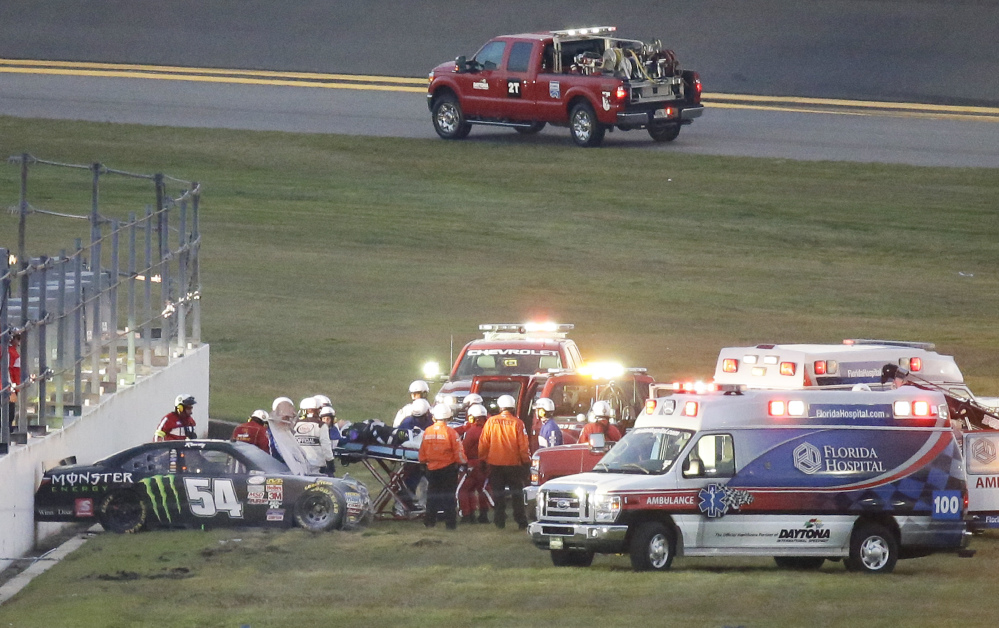DAYTONA BEACH, Fla. (AP) — Kyle Busch will miss the Daytona 500 after injuring his right leg in a vicious hit Saturday into a concrete wall during the Xfinity Series race at Daytona International Speedway.
Busch was injured with eight laps remaining when his car slammed head-on into an interior wall that did not have an energy-absorbing SAFER barrier. He was only able to climb halfway through his window and was pointing in the direction of his right leg when rescue personnel arrived.
Busch was pulled from the car and laid on the ground, and his leg appeared to be stabilized in a splint before he was placed on a stretcher then into an ambulance. His wife, Samantha, was crying as she left the infield care center with team owner Joe Gibbs and team president J.D. Gibbs. Samantha Busch is pregnant with the couple’s first child, a boy due in May.
Busch was transported to a hospital, and NASCAR announced roughly an hour later that Busch won’t participate Sunday in the Sprint Cup Series’ season-opening Daytona 500.
Joe Gibbs Racing did not immediately announce a replacement for the No. 18 Toyota.
As Busch was being treated in a hospital, older brother Kurt was in front of NASCAR’s final appeals officer trying to get his indefinite suspension lifted.
Even if Busch wins the appeal, his Stewart-Haas Racing team appeared set to use Regan Smith in the Daytona 500 — meaning the race would go on without one of the Busch brothers for the first time since 2000.
Ryan Reed won the race, his first career national series victory, in the debut event for Xfinity as sponsor of NASCAR’s second-tier series.
Reed, the 21-year-old driver for Roush Fenway Racing, passed Brad Keselowski for the lead on the last lap to grab the win. Diagnosed four years ago with Type 1 diabetes, Reed thanked sponsor Eli Lilly, which runs a “Drive to Stop Diabetes” campaign.
“I thought I would never drive a race car again. Now, I’m standing here in victory lane at Daytona with Roush Fenway,” he said. “Not only for me and my family, but every kid who gets diagnosed with diabetes or anything that says you can’t do something. Just go and there and overcome it and do it and win and do the best you can.”
But the focus was on Busch’s injury, which occurred when his car slid fast through the grass and slammed into a wall that did not have the Steel and Foam Energy Reduction barriers that were one of the many safety initiatives that came about after Dale Earnhardt’s death in 2001. The SAFER Barrier debuted in 2002 at Indianapolis Motor Speedway.
The walls were developed by Dr. Dean Sicking at the University of Nebraska and are currently installed in some form at every track used by NASCAR’s top series.
The barriers, a combination of steel and foam, cost about $500 a foot which can be a hefty bill at a 2.5 mile superspeedway like Daytona. The soft walls absorb the energy during impact and lessen injuries sustained to a driver.
Tracks only install SAFER barriers where NASCAR recommends to them they should be placed. NASCAR, meanwhile, cites evaluations of high-impact areas in deciding where the material should be placed.
There have been numerous hard hits over the years in areas that were not protected with SAFER barrier, and it often has been rectified by the time the series returns. In 2013, Denny Hamlin hit an unprotected section of wall in Fontana, Cali., that caused a fractured vertebra.
NASCAR had Auto Club Speedway install SAFER barrier where Hamlin hit before the series returned last year. Las Vegas Motor Speedway did the same following a hard Jeff Gordon hit in 2008.
Reaction was swift on social media from drivers calling on NASCAR to install the energy-absorbing material everywhere at race tracks.
“It’s beyond me why we don’t have soft walls everywhere,” tweeted six-time champion Jimmie Johnson.
Former driver Jeff Burton, now a television analyst, called on NASCAR to overcome costs, “It’s very expensive but we have to find a way.”
And Smith, who earlier in the race rolled his car for the first time in his career, said it was inexcusable in 2015 for tracks hosting national events not to have SAFER barriers everywhere.
“I’m genuinely furious right now,” tweeted Smith, the driver who will replace Kurt Busch in the Daytona 500.
After the race, second- and third-place finishers Chris Buescher and Ty Dillon also called on SAFER barriers at race tracks.
“I think we’re to the point now in NASCAR where we should have SAFER barriers at places like this,” said Dillon, grandson of Richard Childress.
“We’re going so fast, there should be SAFER barriers everywhere. I think we can probably afford it. I hate to hear about anybody in our sport getting injured. The sport’s advanced so far in safety that we shouldn’t have any crazy, bad injuries.”
Buescher, who pushed his teammate Reed to the win, noted that drivers seem to routinely hit in the areas that don’t have SAFER barriers.
“We keep running into situations where people find spots that aren’t thought of before,” Buescher said. “The sport has progressed so far, and the safety aspect, that we start to take it for granted. There’s not really room to do that. In my opinion, it needs to be as safe as possible, and if that means lining the inside walls as well, it’s probably a good idea.”
Send questions/comments to the editors.



Comments are no longer available on this story